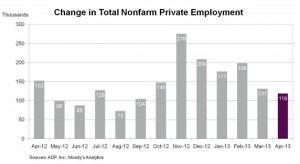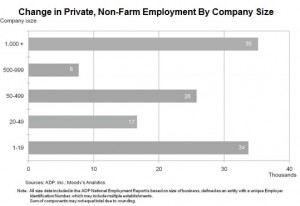 The news about April’s job growth is not looking good. Economists were predicting a mediocre month even before ADP released its estimates this morning, but the company’s numbers took even the more bearish of them by surprise.
The news about April’s job growth is not looking good. Economists were predicting a mediocre month even before ADP released its estimates this morning, but the company’s numbers took even the more bearish of them by surprise.
The HR services firm, which handles payrolls for more than 20% of the U.S. workforce, reported the nation added 119,000 private sector jobs in April and it also lowered its March number from 158,000 to 131,000 jobs. Surveys of labor economists had the consensus estimates of the April ADP number in a range of 150,000 to 155,000.
The ADP report is seen by investors and economists as a predictor of the official government employment report that will be released Friday by the U.S. Labor Department. Because of different counting methods (the government uses a survey, ADP uses actual payroll information) and the inclusion of government jobs in the Labor Department numbers, the two jobs reports rarely synch up precisely. However, both are closely watched for signs of employment trends.
“While it cannot be said enough that the ADP report, while helpful, is hardly a perfect guide to Friday’s payroll report, weakness in the number is never welcome,” Dan Greenhaus, an analyst with BTIG LLC, an institutional brokerage firm, told The Washington Post. “And by and large, that’s what today’s report was; weak.”
ADP’s April numbers, the lowest since September when it reported 105,000 private sector jobs, suggests hiring generally is slowing.
“Job growth appears to be slowing in response to very significant fiscal headwinds.,” said Mark Zandi, chief economist of Moody’s Analytics, which handles the data analysis for ADP. “Tax increases and government spending cuts are beginning to hit the job market. Job growth has slowed across all industries and most significantly among companies that employ between 20 and 499 workers.”
Employers in that range added 26,000 workers in April, a job growth that has been declining since December when the sector accounted for 112,000 jobs. By comparison, last month firms with fewer than 50 workers added 50,000 jobs. Those with 500 and more workers added 43,000 jobs, most (35,000) at employers with more than 1,000 workers.
 Job growth at employers with the smallest employee counts has also been slowing since the beginning of the year. In January, companies with fewer than 50 workers brought on 106,000 new workers.
Job growth at employers with the smallest employee counts has also been slowing since the beginning of the year. In January, companies with fewer than 50 workers brought on 106,000 new workers.
Zandi speculated that next year’s deadline for employee health care coverage may be keeping the smallest employers from adding new staff. The law requires companies with 50 or more workers to offer them health coverage or pay a penalty of as much as $2,000 per worker. “It feels like health care is having an impact,” he said.
Somewhat surprisingly, The Conference Board reported Tuesday that the number of new jobs posted online increased in April for the first time since January. The 204,300 posting increase erases declines in February and March and is also the largest increase since since December, when 215,100 postings were added. Postings, however, don’t necessarily translate into new hires, though a steady increase over several months does point to a hiring trend.
As June Shelp, Conference Board VP, observed, “The 204,000 rise in April is a good sign, but the question is: Will the improvement hold next month and will employers begin to add workers instead of just replacing those who leave?”
The Conference Board also this week released its Consumer Confidence Index. It rose 6.2 points in April, after declining in March. One of the ingredients that go into the calculation — consumers’ outlook for improvement in the labor market — improved during the month. Reported The Conference Board:
Those expecting more jobs in the months ahead improved to 14.2 percent from 13.0 percent, while those expecting fewer jobs decreased to 22.4 percent from 26.0 percent. The proportion of consumers expecting their incomes to increase rose to 16.8 percent from 14.6 percent, while those expecting a decrease declined to 16.0 percent from 17.7 percent.